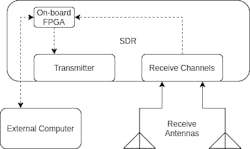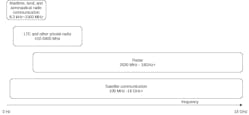Reprinted with permission from Evaluation Engineering
The proliferation of digital technology has introduced an unprecedented reliance on access to the wireless spectrum. Wireless communication is now used virtually everywhere, which has offered significant sociological and economic benefits worldwide. For institutions, organizations and individuals operating applications using RF, it can be very important to know who and what is making use of the spectrum.
Spectrum monitoring has become a critically important task in many sectors to help identify spectrum use and ensure compliance with standards and government regulation. While software-defined radios (SDR) are helping to drive wireless innovations through rapid development, deployment, modifications, and upgrades, they are also simplifying the development of spectrum monitoring solutions. The core purpose of spectrum monitoring is to capture slices of the spectrum for analysis and storage.
Although conventional radios can be designed to capture specific regions of spectrum, it is often more efficient to leverage SDRs for this purpose, since they can be reprogrammed to monitor varying regions of spectrum. SDR platforms bring the speed of software development into hardware-based solution. The reconfigurable nature of SDRs allows them to better support the dynamic and wideband requirements of spectrum monitoring.
Interference Identification and Tracking
Spectrum monitoring has many applications, but interference identification and tracking is one of the more critical use cases. Sources of interference can include neighboring cell tower, nearby Radar systems, or satellite-based communication. Any of these sources have the potential to interfere with critical infrastructure, communication, or defense systems, posing a serious threat in a communication-oriented world. Signals captured through spectrum monitoring can have widely varying properties depending on their source.
Variables such as propagation range, signal source, and the selected protocol can cause significant variance in power levels, bandwidth, and duration of the signal. Longer-duration signals can readily be identified, but often short, bursty signals can be difficult to capture without high performance, wideband radios. Due to this signal variance, the ability to fine tune SDRs to different bandwidth and carrier frequencies is part of what makes them the state-of-the-art solution for spectrum monitoring and signal capture (Fig. 1).
Wideband Operations and Considerations
Monitoring large bands of spectrum is no simple feat. Capturing wideband signals produces significant amounts of data which poses both a storage and computational problem. Increasing the captured bandwidth allows for increased information to be acquired, but will decrease the sensitivity of the radio receiver, making lower power signals more difficult to capture.
As such, it is important to be able to vary the bandwidth of the receiver to obtain the optimal sensitivity-bandwidth trade-off. Recent advances in technology have allowed for a single radio channel to capture GHz of continuous bandwidth.
These technological innovations are being reflected in newer wireless standards; 5G supports a maximum non-aggregated bandwidth of 100 MHz which can be aggregated for a total of 500 MHz. As the hardware used to generate and capture these signals continues to become more widely available, the amount of wideband spectrum uses will continue to increase. Monitoring broadband spectrum will therefore require a radio receiver that can capture a significant portion of spectrum continuously, instead of aggregating multiple narrower bandwidths together, since the signal source properties are often unknown. Use of high-performance SDR receivers can help mitigate the risk of missing the interception of short-duration signals and will simplify the data acquisition and processing portions of spectrum monitoring.
The majority of civil, defense, and public safety communication occurs in frequency bands less than 18 GHz. Figure 2 shows typical spectrum use from DC to 18 GHz. Radio communication for land, maritime, and aeronautical radio systems typically occur in frequency bands less than 1.5 GHz. Satellite and Radar bands are distributed across almost the entire spectrum. LTE and other communication systems will primarily occupy the 410-5900 MHz band. Use of bands above 18 GHz is becoming more frequent but is still not commonplace in non-niche applications.
Frequencies above 18 GHz will experience increased propagation path loss resulting in the capture of these signals becoming increasingly difficult. Recent technological advances strongly support high channel bandwidth but attempting to monitor 18 GHz of spectrum poses a serious radio architectural problem. A single radio receiver channel cannot monitor so much bandwidth without changing the carrier frequency. Utilizing a swept carrier receiver would enable a system to monitor 18 GHz of continuous spectrum, but the sweeping process will probabilistically fail to capture bursty signals since the sweep time is not infinitely small nor the captured bandwidth infinitely large.
Conventional radios could be used to monitor fixed regions of spectrum but capturing a significant portion of spectrum becomes costly since the bandwidth and carrier cannot easily be changed. An SDR implementation will provide the best of both solutions. Spectrum monitoring solutions leveraging SDRs will have the ability to reconfigure the hardware to capture various signals of interest without prohibitive cost or complexity.
Benefits of Adjustable and High Bandwidths
The objective of spectrum monitoring is to determine who or what is using certain regions of the wireless spectrum. Devices making use of the spectrum are not always known to the spectrum monitoring receiver, and as such the properties of the captured signals are often partially unknown. High channel bandwidths help simplify the signal identification process required in spectrum monitoring. If the exact carrier frequency of a signal is unknown, capturing a wider region of bandwidth will enable the signal to be discovered and the carrier information to be more readily extracted.
Alternatively, high channel bandwidths allow for shorter duration or wideband signals to be captured, such as Radar pulses. If the bandwidth of the broadcasted signal is larger than the capture bandwidth of the receiver, the signal may be incorrectly identified, which could have serious consequences depending on the spectrum monitoring application.
Despite higher bandwidths decreasing the signal-to-noise ratio of the captured signals, preliminary monitoring efforts will often capture a large spectral region. This will allow for the bandwidth of a signal to be estimated to avoid partial information extraction. After a signal of interest is captured, an SDR can be reconfigured to capture a narrow bandwidth which is occupied only by the signal, allowing for improved noise performance. SDRs excel in the spectrum monitoring application since the reconfiguration of their hardware is nearly instantaneous and allows for the optimal quality of the captured signal through capture bandwidth reduction.
Wideband signal capture with any radio will result in significant amounts of data being captured. Programmable bandwidth will allow for SDRs to reduce their bandwidth to collect only a sub-section of spectrum. Not only will this allow for more efficient data collection, but it will also increase the sensitivity of the measurement receiver. The variable bandwidth of SDRs can make the difference between a high-quality signal capture, a low-quality signal capture, or missing the signal altogether.
Channel Count
Despite SDRs being capable of optimizing the captured signal-to-noise ratio through bandwidth reconfiguration, use of a single radio channel may decrease the probability of interception. If a signal has a low-power or a large bandwidth, the signal might not be properly captured due to poor signal-to-noise ratio. A single SDR channel in a wideband configuration might be able to identify that there is a signal present but have a sensitivity that is too low to extract meaningful information from the signal.
To circumvent this, the SDR could be reconfigured to a smaller bandwidth to enhance the quality of the signal of interest captured. While the bandwidth reduction will increase the measurement quality, it will also result in a large portion of spectrum being unmonitored. It is for this reason that robust spectrum monitoring solutions must utilize multiple independent receive channels. Multiple independent receive channels will allow for some channels to perform broadband monitoring for signal discovery, while other channels are used to capture signals of interest with improved sensitivity. Use of a multi-channel SDR will simplify this process in that some channels can be configured for wideband capture to identify the presence of a signal of interest and other channels can be reconfigured for narrow band capture on the signals of interest.
This will not only help increase the quality of the captured data but will also allow for less data needing to be stored long term. Pre-processing on wideband signal captures can be used to select sub-sections of spectrum to be re-collected using a narrower bandwidth receiver. The software reconfigurability of SDRs will allow for this process to be largely automated. A wideband receive channel could monitor a wideband portion of spectrum for a spike in signal power which could then trigger a narrowband receiver to be reconfigured for the sub-band of interest.
The addition of more radio channels will allow for more information to be captured. Utilizing MIMO signal processing techniques can leverage the spatial properties of the radio channels to increase the captured energy of the signals of interest. While multiple radio channels will increase the received signal power, they will also provide spatial information of the captured signal. Spatial information will allow for estimation of the angle of arrival which can be invaluable for defense and interference tracking spectrum monitoring applications.
A benefit of SDRs is that numerous radio channels can be co-analyzed using MIMO processing techniques for capturing sub-sections of spectrum but can then be reconfigured back to different bandwidths or signal processing architectures. The limitless reconfiguration options of multi-channel, wideband SDRs allows for them to be adapted to excel in any spectrum monitoring or communication solution. They allow for the benefits of narrow and wideband radios to be combined into a single reprogrammable system.
Benefits of Using SDRs
Uncertainty and variation of the captured signal properties requires that receivers used in spectrum monitoring applications be highly reconfigurable. The dynamic nature of SDRs strongly positions them as the ideal platform because of their reconfigurability. A conventional radio could be configured or optimized specifically for LTE, 5G, or Bluetooth communication and spectrum monitoring. Conversely, SDRs are protocol agnostic and allow for concurrent signal processing of an arbitrary number of wireless systems. SDRs typically have multiple channels with high bandwidth which supports high performance spectrum monitoring applications.
Processing multiple wideband channels with several protocols concurrently is computationally intense. A wideband spectrum monitoring solution can easily generate gigabits of data per second and processing this data in real-time presents a significant problem. Most SDR solutions have an FPGA hosting part of the radio system. Portions of the FPGA fabric can be used to allow for pre-processing and parallel processing of the captured signals. Having the FPGA closely integrated with the receiver helps reduce the system complexity and processing latency. Pre-selection of data can also be performed in the FPGA to help reduce the volume of data passed to downstream processors such as CPUs and GPUs.
An SDR with many independent channels and high bandwidth will capture significant amounts of data. While this does further increase the processing difficulty, higher bandwidths and channel counts can significantly increase the probability of signal interception and the captured signal quality. Conventional radios do not easily support dynamic resource allocation which severely constrains the monitoring system. In other words, the bandwidth and carrier frequency of non-SDRs are not easily adjusted resulting in worse temporal and spatial information extraction from multiple independent radio channels.
Selection of an SDR for a spectrum monitoring solution requires careful consideration. Many SDR vendors offer radios with tens of MHz of bandwidth and carrier frequencies adjustable up to 6 GHz. SDRs of this caliber can be adequate for educational and preliminary testing but industrial spectrum monitoring applications are often much more demanding. Per Vices is a premier SDR vendor whose robust SDR solutions can be leveraged to monitor significant portions of spectrum with very low noise and high precision. Currently, Per Vices offers two turnkey SDR platforms with several levels of performance to meet any spectrum monitoring solution’s requirements.
For example, the Crimson TNG SDR offers 4x4 independent transmitters and receivers, with 325 MHz bandwidth per channel and a maximum frequency of 6800 MHz. The Cyan SDR offers up to 16 independent receive chains with up to 1 GHz bandwidth per channel and a maximum frequency of 18 GHz. Both radios have spurious free dynamic ranges of 65 dB meaning the captured data can meet even the most stringent monitoring performance requirements. The ultra-wideband performance, significant carrier frequency range, and high number of independent radio channels makes Per Vices’s SDRs the premier radio hardware for modern spectrum monitoring solutions.


